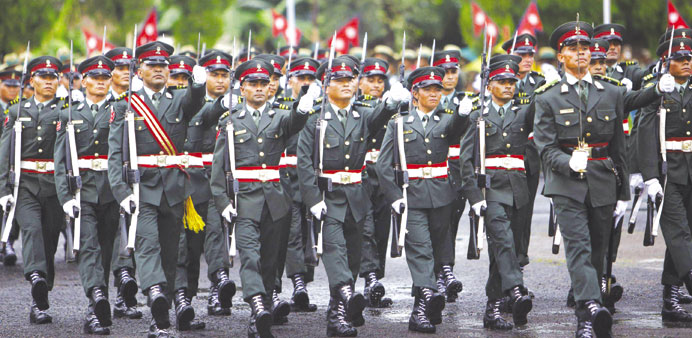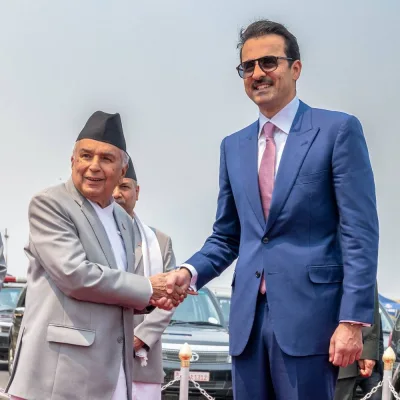Former Maoist rebels taking part in a parade after being integrated as lieutenants into the national army, as part of a peace deal, at the Nepal Military Academy in Kharipati, Bhaktapur, yesterday.
Reuters/Kharipati, Nepal
Nepal commissioned a group of former Maoist rebel fighters as officers in the national army yesterday, fulfilling a main component of a fragile peace deal that ended civil war but has failed to bring political stability to the Himalayan nation.
Some 70 Maoist fighters who battled the army in the decade-long conflict that ended in 2006 joined their former foes in a parade at the Nepalese Military Academy at Kharipati, 20km east of Kathmandu.
The army had initially resisted integrating the Maoist guerrillas, saying they were politically indoctrinated.
In total, 1,460 of the 19,600 fighters registered by the UN after the war have joined the army. The rest left camps for civilian life, some with a rehabilitation package of up to $10,200.
Former fighter Anil Rokaya said he was happy to join the army and had put the past behind him.
“There is no question of bad feelings. That was a different time when we fought and the context has changed after the peace process,” said the 26-year-old.
Dressed in dark green military uniforms, the last fighters received the insignia of their new positions in the army from Khilraj Regmi, chairman of the caretaker cabinet that is governing Nepal before elections due in November.
“This is a matter of happiness for all that the integration process has completed successfully,” Regmi said.
But Nepal is some way from normality. Seven years after the end of the war, it is still without a new constitution, and successive governments have collapsed because of differences about the course the young republic should take.
The Maoists emerged as the biggest party in an election in 2008 for a special Constituent Assembly, which subsequently abolished the 239-year-old Hindu monarchy and turned Nepal into a secular republic.
Bharat Pulami Magar, who battled the army for five years, said the fall of the monarchy was a result of the conflict.
“This would not have been possible otherwise,” the 33-year-old Magar said, a cream-coloured Buddhist prayer scarf and marigold garland dangling from his chest.
Nepal has scheduled November elections for a second Constituent Assembly to draft the charter after a similar body was dissolved last year without completing it.
About 16,000 people were killed in the war.
Analysts say Nepal will not enjoy lasting peace without a constitution that addresses demands for decentralisation of power to ethnic regions. The economy is in tatters and survivors of the violence that killed thousands are demanding justice and compensation.
“These have not received any attention from the state so far and must now be addressed for sustained peace,” said Bishnu Raj Upreti, who teaches conflict management at Kathmandu University.



